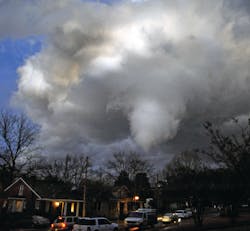This time of year it is not uncommon for agencies to have to prepare for a major hurricane bearing down on a metropolitan area with a large urban transportation infrastructure. Preparations against the emergency management plan will have already begun, which will include getting residents to safety while local transit officials brace for significant damage to local businesses and infrastructure.
Prior to the hurricane's arrival, the city's transit agencies have been working around the clock to keep bus and rail services in operation to evacuate residents from the area. The metropolitan traffic management center has been up and running continuously to track the location and statuses of buses and trains, as personnel direct them into the optimal positions to pick up residents and transport them out of the areas expected to be hit hardest.
Preparing for the worst
Recent natural disasters such as tornadoes, hurricanes, floods and tsunamis have devastated civilian hubs and transportation infrastructure around the world. Coordinating and tracking personnel and resources during such an event was once impossible. Today, integrated voice, video and data situational awareness solutions allow agencies to coordinate preparation activities and keep track of transit personnel and resources to ensure they are in the right position at the right time. LMR (Land Mobile Radio) voice and data radio systems allow transit agencies to establish interoperable communications with other regional transportation agencies, first responders and public safety agencies in real-time, enabling them to coordinate response efforts based on weather information, traffic patterns, road closures and potential flooding.
Landfall Meets Technology
The storm hits the city as expected and many of the residents are dealing with power outages. Power lines are down and many of the roads and tracks utilized by local public transportation are flooded or offline.
These weather conditions on well-traveled roadways are forcing major traffic jams, especially as thousands of residents are attempting to evacuate the region. This uptick in traffic adds a layer of complexity for transit agencies, who need to know where their buses, trains and taxis are across the city as soon as possible. Enter Connected Vehicle technology, which utilizes AVL (automatic vehicle location) data from the onboard systems and data communicated from other agencies. This flow of information allows the transit agency to keep track of every vehicle using voice and data communications through LMR systems, which are integrated with GPS technology at the TMC (transit management center). All regional agencies can remain in contact with their operations personnel using the city's transit radio system, alerting drivers to congested conditions, road closures and evacuation routes. All transit operators are equipped with dual-band radios allowing them to communicate in real-time with the transit officials stationed at the operations center. Decision support at the TMC to relocate citizens is supported with real time video and weather information allowing critical choices to be made quickly and safely.
After hours of unrelenting winds, rain and hail, the storm finally begins to wind down. Transportation managers know they must get all public transit services back online to service residents returning to the city. The residents' transportation choices are limited due to either flooded roads or congested highways. Getting buses and trains back on their respective routes is the priority for the transportation managers. They are using integrated radio, video and CAD (computer-assisted dispatch)/AVL connected vehicle systems to allow for dispatchers and remote client coordination to get back up and running. As the dispatchers track transit resources from the operations center, remote LMR users can gain a bird's eye view using real-time GPS technology to survey traffic with their radios. Onboard video systems also allow drivers to view upcoming intersections.
Advanced Solutions for Safer, More Efficient Operations
While the story described here is fictional, the threat and the solutions are real, and in use around the country. When traditional forms of communications (land lines, commercial cell networks, etc.) go down, LMR solutions can stay operational for transit agencies to remain operational during the worst of conditions. Situational awareness solutions provide transit management, incident commanders, transit operators with accurate locations of their service vehicles and local conditions. These solutions enable users to respond to incidents and issues more efficiently and effectively than previous technologies, and they are supported by the strength of integrated transit wireless voice, video and data radio systems, which provide critical communications to hundreds of agencies around the world.
Barry Einsig is the transportation market director for Harris Public Safety and Professional Communications.



